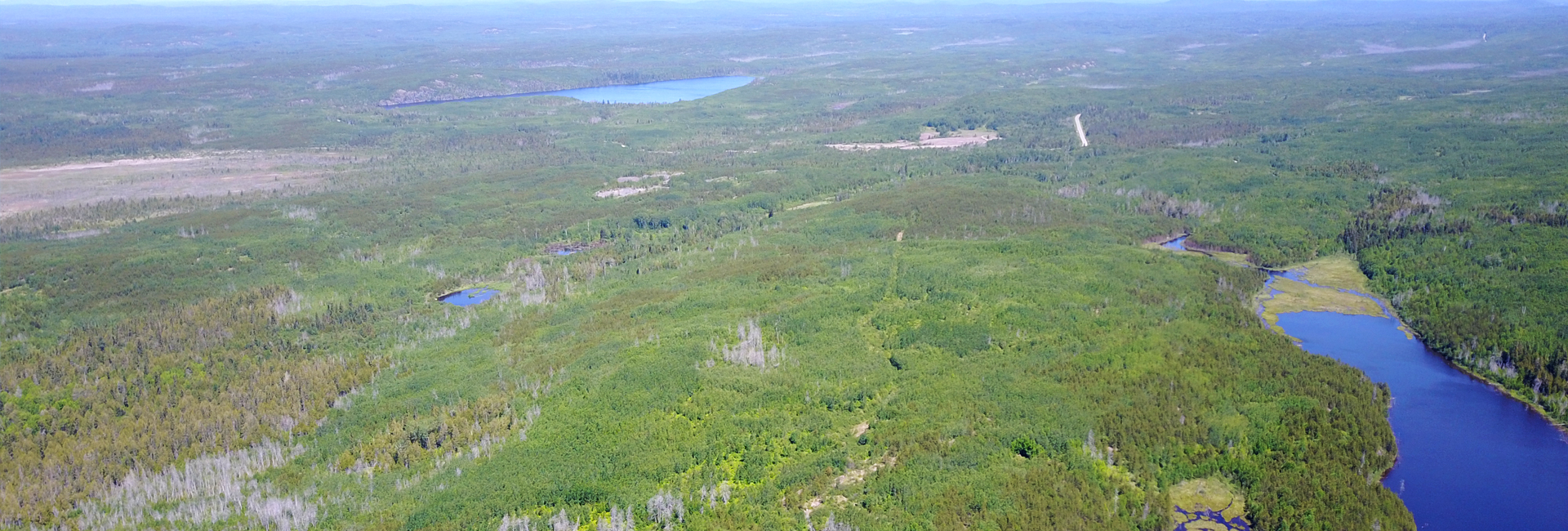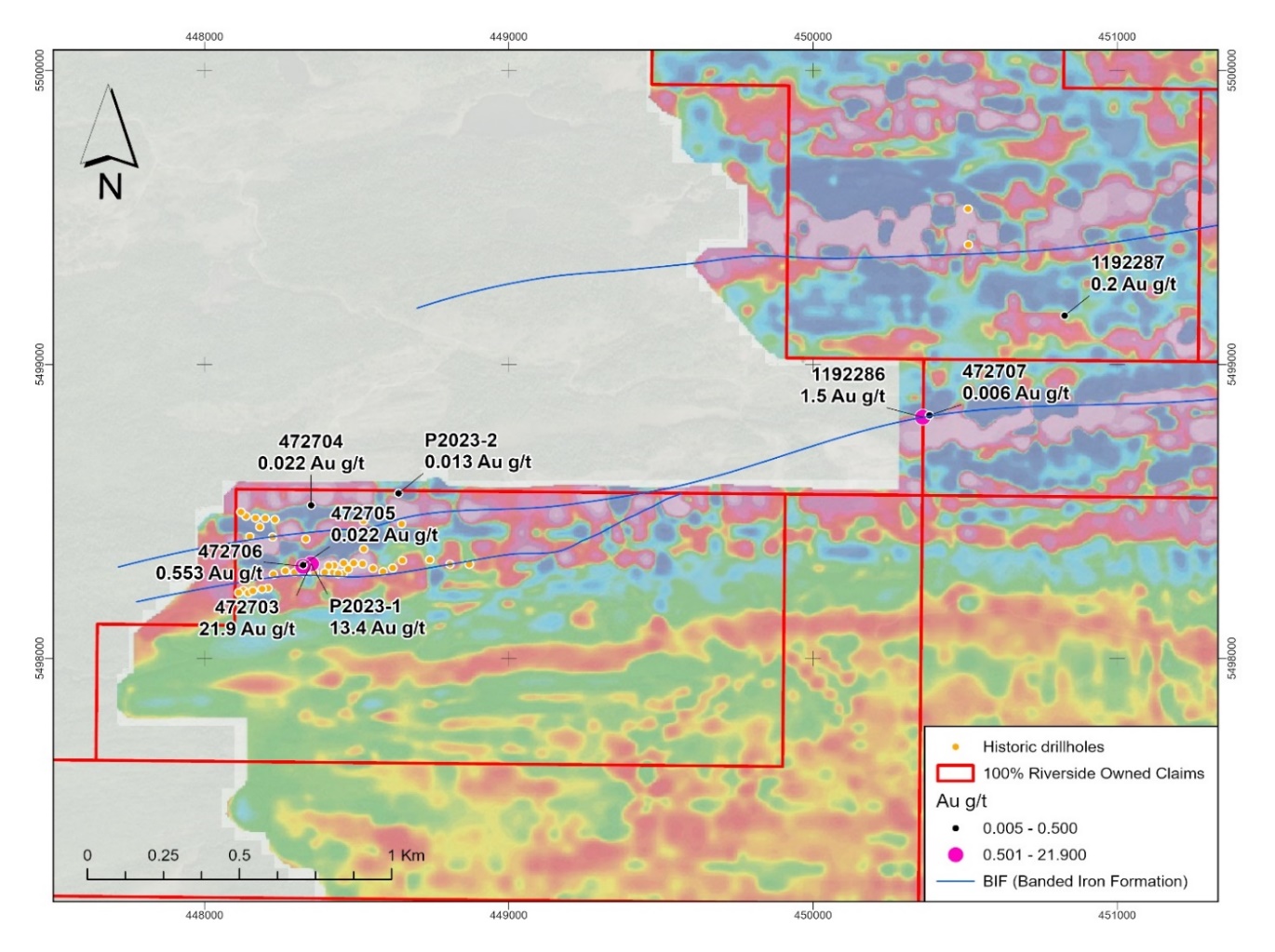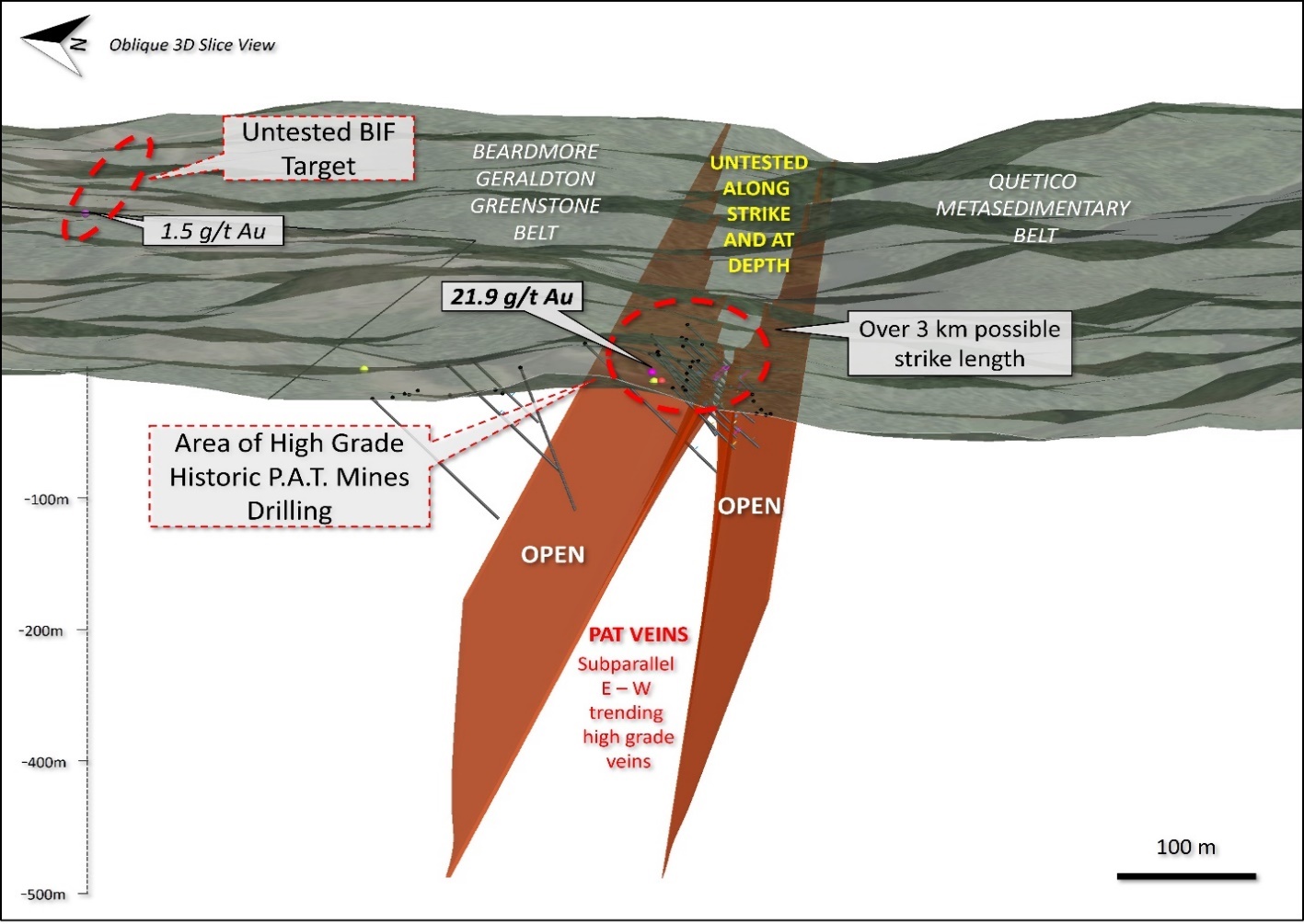Targets
Figure 1: Sampling by Riverside in 2023
Riverside’s first-phase exploration program defined several target areas for follow-up survey work and drill target refinement (see Figure 3 below). There are several (3m wide) shear zones defined by strongly foliated material. Two of these shears were noted to be located along the boundary of iron formations as at the Pichette showing and pose a highly prospective target planned for further follow-up and potential drilling.
Figure 2: Drill targets identified by modelling the historical 1952 drilling (non NI43-101 compliant)
The 2022 drone magnetic survey identified several prospective targets in the east-west BGGB corridor. There is a direct relationship between structures and mineralization in the Pichette Project. Faults often function as corridors or plumbing tapping into deeper parts of the crust. Some of the structures on site indicate both sinistral and dextral components, which is to be expected, and indicates the structures have been active for a long time and had numerous opportunities for mineral precipitation and deposition. Polar diagrams of structural vein data by Riverside show a marked trend at N85E indicating a close relationship between the main structural patterns and mineralization previous interpretations invoked orogen-parallel dextral transcurrent faulting as the main structural control on the emplacement of gold mineralization in the BGB. Gold mineralization was thought to be coeval with the formation of structures and dilational zones during regional dextral transcurrent faulting, such as the hinge of Z-shaped folds, dextral shear zones at the contact between rock units, and reactivated thrust faults at the contact between panels of metasedimentary and metavolcanic rocks.
Recent work by Dr. Zsuszana Toth states that gold was emplaced earlier during the structural history of the belt and involved two stages of gold mineralization. The hydrothermal mineralization history of the Geraldton camp began with the formation of quartz-carbonate veins and early bedding-parallel Fe-carbonate alteration during D1 faulting and thrust imbrication of the belt. These veins and early Fe-carbonate alteration were folded and transposed along the Bankfield-Tombill deformation zone as panels in the belt were regionally folded and shear became localized along higher strain deformation zone during regional D2 sinistral transpression. Hydrothermal fluids flowed into the Bankfield-Tombill deformation zone, and auriferous quartz-tourmaline and quartz-carbonate veins were deposited across S-shaped folds that formed during sinistral shearing along the deformation zone. Reactivation of the deformation zone during regional D3 dextral transpression rotated and boudinaged these veins and redistributed or introduced new gold and other metals into localized dextral faults and shear zones.
The complex hydrothermal fluid history of the Geraldton Camp is recorded by the textures of pyrite grains and their chemical composition. Inclusion-poor pyrites and metal-rich, inclusion rich pyrites are associated with both syn-D1 and syn-D2 vein generations. They formed during fluid-rock sulfidation reactions with their metal content reflecting that of the hydrothermal fluids. Gold was then redistributed, or new gold and other metals were introduced, during the infiltration of late fluids along microfractures cutting across sulfide minerals and other alteration minerals. As this process occurred at different times during the formation of the Geraldton gold deposits, recent work exemplifies how the juxtaposition of multiple mineralization events and the redistribution of metals during the prolonged structural history of a major deformation zone can result in the formation of complex ore deposits (Tóth, 2019).
DEPOSIT in the Beardmore- Geraldton Greenstone Belt
The Geraldton region has a long and rich mining history and has produced 4.1 million ounces of gold over the past 100 years including the combined MacLeod-Cockshutt Mine, which produced 1.5 million ounces of gold up to 1970. The MacLeod-Cockshutt Mine at Geraldton, and the Central Patricia and Pickle Crow mines in Pickle Lake outside the BGB are non-stratiform deposits.
Non-stratiform deposits contain sulfide-rich alteration zones immediately adjacent to late structures and are like mesothermal vein-type gold deposits. Late quartz veins and/or shear zones are present in most known BIF-hosted gold deposits. The distributions of gold-bearing veins and sulfide-rich zones are commonly controlled by fold structures. Major faults of regional scale have been recognized near many non-stratiform deposits. Irregular, massive lenses of sulfides and quartz occur in a folded series of greywacke and iron formation in the Hard Rock and MacLeod-Cockshutt mines. These massive replacement lenses (up to 65%, sulfides) cut the folded iron formation and are elated to quartz-carbonate veins up to 0.6 m wide. Veins are usually barren of gold mineralization except where they contain sulfides; primarily pyrite, arsenopyrite and pyrrhotite. In other areas mineralization in veins and shears is found in metavolcanic rocks often in association with contact zones between mafic and felsic rocks.
More recently, the Hardrock Project held by Greenstone Gold Mines has elevated attention to the area by announcing their intention to mine their gold resource near Geraldton, Ontario. Greenstone Gold Mines is a 60/40 partnership between Equinox Gold and Orion Mine Finance. The deposit is centered on a complex of refolded folds where the axes of the main folds plunge at low angles to the west. The fold complex has undergone high strain brittle-ductile deformation and hydrothermal fluid flow appears to have been partly channeled. The Hardrock Project hosts 4.5M ounces in probable reserves and mineral resources 4M ounces in resources (measured and indicated). Mineralization at Hardrock is hosted in several bedrock types but primarily in tightly, folded metasedimentary metavolcanic and porphyritic rocks.
The Hardrock Deposit 55km to the east has been subject to several phases of folding through fractured rocks that developed in megascopic fold closures https://www.greenstonegoldmines.com/
To the west in Beadmore several high grade deposits have been discovered. The Lietch Mine is notable because of its high grade. The mine produced 850,000 ouces gold from 920,000 tons and is said to be the highest grade gold mine in Canada.



